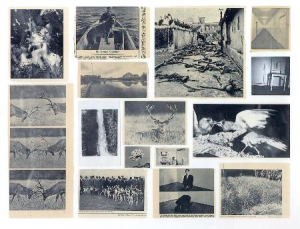The term Atlas rings perhaps more familiar in the German language than it does in English, being defined since the end of the sixteenth century as a book format that complies and organizes geographical and astronomical knowledge. We are told that this format received its name from one of Mercator’s map collections in the 1585 which carried a frontispiece showing an image of Atlas, the titan of Greek mythology who holds up the universe at the threshold where day and night meet each other. But later, in the nineteenth century, the term had been increasingly deployd to identify and tabular display of systematized knowledge and one could have encountered an atlas in almost every field of of the empirical sciences: an atlas of astronomy, of anatomy, geography and ethnography, and titan who held up the heavens. When the confidence in empiricism and the aspiration towards comprehensive completeness of positivist systems of knowledge withered in the twentieth century, the term ‘Atlas’ seems to have fallen into a more metaphorical usage.
Archive for Abril, 2009
EXCURSOS ON THE ATLAS
10/04/2009GERHARD RICHTER’S ATLAS
10/04/2009“Memory is thus conceived of Richter’s Atlas first of all as an archaeology of pictorial and photographic registers, each of which partakes in a different photographic formation, and each of which generates its proper psychic register of responses. While all of them operate separately (and in relative independence from each other) in the perceptual and the mnemonic apparatus of the subject, they all intersect, constituting precisely that complex field of disavowals and displacements, the field of repression and cover images within which memory is constituted in the register of photographic order.”
Benjamin H. D. Bucholoh in The Archive, Charles Merewether, 2006
Lost Formats Preservation Society
08/04/2009
The society was founded in 2000 by Experimental Jetset with the design of Emigre issue no. 57. It’s sole purpose is to save formats from obscurity.
«Internet Mapping Project»
08/04/2009
The map of the Internet topology by Hal Burch and Bill Cheswick shows the structure of the Internet from December 2000, representing nearly 100,000 network nodes. This highly complex spatialisation takes several hours to generate on a typical PC. The layout algorithm uses simple rules, with forces of attraction and repulsion jostling the nodes into a stable, legible configuration. There are many permutations in the algorithm to generate different layouts and colour-codings of the links according to different criteria (such as network ownership, country).
by Martin DodgeThe Art of Memory
01/04/2009“Few people know that the Greeks, who invented many arts, invented the art of memory which, like their other arts, was passed on to Rome whence it descended in the European tradition. This art seeks to memorize through a technique of impressing “places” and “images” on memory. It has usually been classed as “mnemotechnics”, which in modern times seems a rather unimportant branch of human activity. But in the age before printing a trained memory was vitally important; and the manipulation of images in memory must always to some extent involve the psyche as a whole.”

